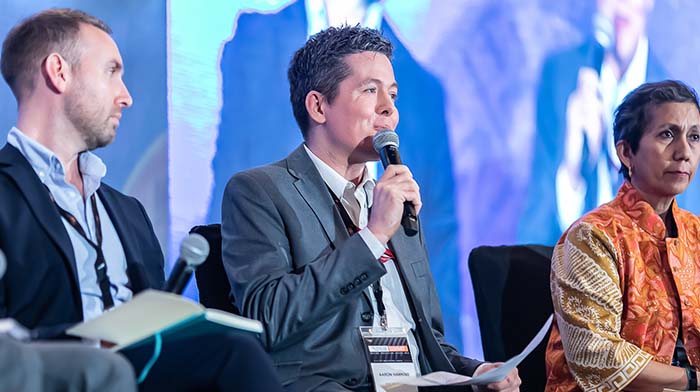
News & Events
Cross-sector Collaborations to Deliver Positive Health Outcomes to Society
Ahead of the 5thARoFIIN Roundtable happening on 1 August 2019 in Bangkok, Thailand, Aaron Hawkins, Deputy Project Director of the Good Nutrition on Tea Estates (Sri Lanka) at Save the Children, Massimo Reverberi, Founder of Bugsolutely and Allison Hollowell, Chief Strategy Officer of the Asian Venture Philanthropy Network (AVPN), share their insights on the challenges that the world is seeing today in terms of improving health and nutrition, and the importance of multi-stakeholder collaborations to tackle the issue of malnutrition in Asia.
1) What do you think are the key challenges that the world is facing today in terms of improving health and nutrition?
 Aaron Hawkins, Save the Children: Many countries around the world are facing numerous challenges related to nutrition. The first has to do with the parallel growing abundance of consumer choice and rapid urbanisation. This means that consumers know less about food and yet are overwhelmed by choice.
Aaron Hawkins, Save the Children: Many countries around the world are facing numerous challenges related to nutrition. The first has to do with the parallel growing abundance of consumer choice and rapid urbanisation. This means that consumers know less about food and yet are overwhelmed by choice.
The second has to do with growing economic disparities within countries which has resulted in the rise of both undernourished and overnourished (obese) people. At the same time, you have micronutrient deficiencies that affect all, leading to long-term issues of malnutrition for all socioeconomic layers of society. This is often described as the triple burden of malnutrition which is pervasive in many Asian countries.

Massimo Reverberi, Bugsolutely:We are clearly living in an unbalanced world in terms of access to good food. I would say that the world can be divided into three nutritional areas –
Where food security is not a problem and food safety is generally good. Obesity and other disease related to alimentary “excesses” may exist in these countries, but the trend is definitely toward healthy foods;
Where food security is not a problem, but food safety is, and these countries are shifting from a farmer’s society directly into a “convenience store” food culture;
Where malnutrition and low food safety are due to poverty, and people live in a “survival mode” permanently.

Allison Hollowell, AVPN: Economic growth and development has seen the growth of the middle income, who now has greater access to food, but not necessarily nutritious food. Obesity used to be considered a problem reserved for developed countries, but economic growth has granted populations across the globe access to junk food and drinks that are high in trans-fat and sugar with low nutritional values. Coupled with physical inactivity and sedentary lifestyles, those in this income bracket are increasingly faced with the burdens of obesity and obesity-related non-communicable diseases such as early onset adolescent diabetes and high blood pressure.
These diverse experiences have resulted in growing social and economic inequalities, both globally and nationally. This is particularly true in Asia where 1 in 3 people has been identified to be malnourished. This double burden brings negative economic consequences, with undernutrition in Asia and Africa estimated to reduce GDP by 11% annually, whilst obesity could cost Asian countries approximately USD 166 billion annually.
2) How important are partnerships to unlock change at the rate and scale needed to make better health a reality for more people in Asia?

Aaron Hawkins at the FIA Food for the Future Summit 2019
Aaron Hawkins: Partnerships are critical to being able to unlock promising change at a reasonable rate and scale. In Asia, the huge populations alongside rapid development make it important to seize the promise of industry, the voice of the community, and the power of government to drive the change for nutrition. Often, the missing link is a facilitator between these sides and a partner who can effectively engage the community.
This is where I believe non-governmental organisations (NGOs) can help. By building on their relationships with the government and the community, NGOs can find winning solutions for all sides to ensure that the community, public, and private sectors see their role in change and use their partnerships as a driving force to tackle malnutrition.
Massimo Reverberi: Investors, corporations and the distribution system should be responsible and supportive towards innovations created for the benefit of many and improving health.
Allison Hollowell: There is no shortage of capital; the challenge is moving more of this capital towards impact. To meet the needs across the entire food ecosystem, a full continuum of capital is needed, from research-driven impact measurement frameworks, to private investments that can build food systems infrastructure, to innovations in tech and sustainable harvesting, to advocacy campaigns to improve consumer consumption.
No one party can pick up this responsibility alone; collective action across stakeholders with different expertise and capital is required to see any transformation. At AVPN, we have more than 240 members working on healthcare and nutrition. With almost half of the AVPN membership passionate about this sector, there is a lot of potential for synergies and collaboration. We saw these partnerships in action at last year’s AVPN Conference, where our members Kellogg, the Power of Nutrition and Sesame Workshop worked with implementation partners working on the ground to address morning hunger in India.
3) What are some steps that the food industry have been taking to accelerate action on ending hunger and nutrition?

“Insects may be small, but in the food market, they are the next big thing.” – Massimo Reverberi
Massimo Reverberi: I am in the edible insect market – a very small one! Start-ups in this new food segment are motivated not just by a business opportunity but also by the environmental and nutritional advantages of eating insects. Similarly, other alternative protein sources such as plants, algae, mushrooms have great potential to provide better food with less resources. Let’s not forget that cattle farming needs so much land and crops, at the expenses of the general availability of food for everyone. Any alternative to red meat is welcome, not just by the environment but also by the people in need of more or better food.
4) How can impact investors fuel further development in the area of health and nutrition?
Allison Hollowell: The Global Impact Investing Network (GIIN) Landscape for Impact Investing in Southeast Asia found that there is very low impact investment in healthcare. Impact investors can invest in early stage impact small and medium enterprises (SMEs) whose success will catalyse new markets and innovations. The AVPN Deal Share has listed 110 Social Purpose Organisations (SPOs) working on health and nutrition that have been endorsed by our members for follow-on support. Just by sheer numbers alone, these SPOs take up approximately one-third of the Deal Share Platform, reflecting the increasing innovative solutions – from last mile health-tech support to scaling up affordable and nutritious alternative food products – developing across Asia-Pacific that is focused on healthcare and nutrition. According to the 2018 Global Food and Agriculture Outlook report by Valoral Advisors, whilst investment towards health and nutrition has been on a steady incline, about 50% of the funds are directed towards North America, while the Asia-Pacific region saw only 6% of all funds.
Impact investors, however, cannot work alone to develop health and nutrition. Philanthropists and governments have to come in to support SMEs, particularly in the seed stages where the financial returns do not compensate for the level of risk. Incubators are also necessary to help build the pipeline of investment-ready social purpose organisations. In Indonesia, the JAPFA foundation leads the nutrition cluster of Filantropi Indonesia and has funded education and training programmes to promote nutrition and healthy lifestyles amongst school going.
5) What do you think is essential to end malnutrition in all forms by 2030?
Aaron Hawkins: Government commitment, private sector engagement, and creative local (community) solutions will be critical ingredients to effectively ending malnutrition by 2030. All three sectors need to be actively engaged and must proactively and aggressively work hand-in-hand to tackle all forms of malnutrition.
Allison Hollowell: At the recent AVPN Conference, we heard from Ertharin Cousin, former Executive Director of the UN World Food Programme, that there are approximately 821 million people globally who are food insecure, and 150 million children suffering from stunting. Another 1.3 billion people are facing micro-nutrient deficiencies, or ‘hidden hunger’. There is huge ambition to address these challenges, but the capital invested into nutrition is very much lacking, and is unequal in its distribution. There needs to be more intentional global efforts to drive a higher proportion of food and agriculture investments, which have tripled between 2004 and 2013 to more than $100 billion, to the Asia-Pacific region. Government action alone cannot address these systemic challenges, and partnerships across all sectors are needed to invest in the entire food ecosystem.

